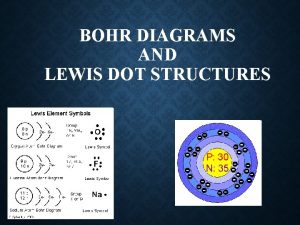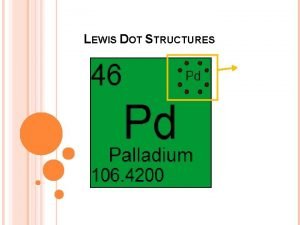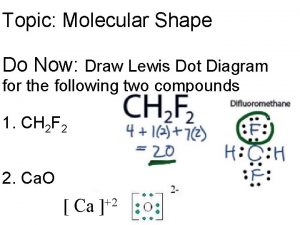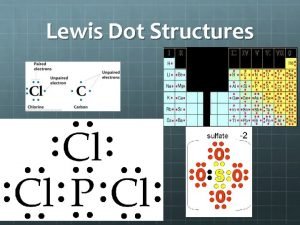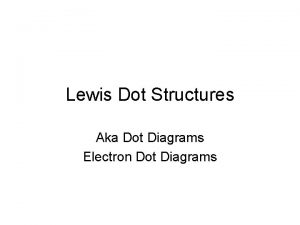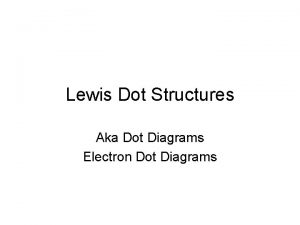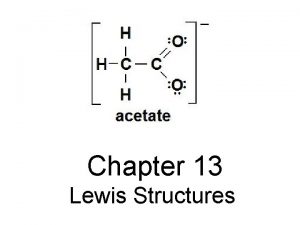Lewis Dot Diagrams Structures Lewis Dot Diagrams Since



















- Slides: 19

Lewis Dot Diagrams / Structures

Lewis Dot Diagrams • Since only valence electrons are part of the chemical reactions, it is useful to show only the valence electrons that are reactive! • We use dots to represent electrons – Like in Bohr models • Except we now only show the VALENCE electrons only and no need for shells

Example - 1 • Draw the Lewis dot diagram of the following – Na – Mg –O

Different Representation • Molecular Formula = F 2 • Dot Diagram = F: F (just dots) • Structural Formula = F-F (just lines to show bonds)

Ionic Lewis Structures • It is the same as Bohr models • The giving away of electrons and the accepting of electrons – So you have to put charges

Example - 2 • Draw the Lewis Structures of the following – Mg. Cl 2 – Mg. O

Practice - 1 • Page 183 - #85

Covalent Lewis Structures • Bonding of 2 or more non-metals • Non-metallic elements when forming covalent bonds will obtain electrons by sharing until they have a stable arrangement of e- such as noble gases • Still must obey the octet rule – Will have to play around sometimes until octet rule is achieved • But there are strategies to drawing

Example - 3 • Draw the Lewis Structure of the following – F 2 – O 2 – H 2

Ideal Number of Bonds • • H, F, Cl, I = 1 bond O, S, Se = 2 bonds N, P, As = 3 bonds C, Si = 4 bonds

Rules for drawing Lewis Structures • Count how many atoms we have and multiply by 8 for octet rule. – This is 8 x # of atoms in structure • Calculate the total number of valence electrons each atom will have • Subtract the two. – This number will give you the number of electrons that will be bonding in pairs

Rules for drawing Lewis Structures • Use the number of valence electron – Start by putting two electrons to bond each atom. • If the chemical formula has an element that is only 1 and another element that is multiple such as H 2 O, put the element that only has 1 in the center and put the other elements surrounding it. – Oxygen in the center and hydrogen around it • Use the remaining valence electron after putting the bonding electrons to complete the octet rule – Fill the surrounding atoms first before center

Rules for drawing Lewis Structures • If any valence electrons remain, fill the central atom • If the central atom doesn’t satisfy the octet rule. – You can rearrange the neighbouring atoms lone pairs/unbonded electrons to make another bond. • Put dashes for any bonds to make it neater • If our molecule is an ion, we add or remove electrons – If it is an ion, we put brackets around it and put the charge in the top right corner

Example - 4 • Draw the Lewis Structures of the following – CO 2 – NH 4+ – CH 4

Exceptions • Hydrogen and Helium only need 2 electrons in its outer shell. – Does not need octet rule • Be, B, and Al are also elements that do not need the octet rule satisfied – They do not need 8 electrons in its valence shell • They have low electronegativity so they cannot attract electrons – We call the molecules formed without octet rule fully filled, electron-deficient molecules

Example - 5 • Draw the Lewis Structure of the following – BF 3

Exception • Elements that have d-orbitals – Elements in the 4 th row and below – Can break the octet rule • They have empty d-orbitals that can allow it to have more than 8 electrons in its valence shell – Think of 2 -8 -8 -18 -18 -32 – The 18 electrons comes from 8 (s and p orbital electrons) + 10 (d orbital electrons)

Example - 6 • Draw the Lewis Structure of the following – PCl 5

Practice - 2 • Page 188 - #86
 Bohr rutherford diagram vs lewis dot diagram
Bohr rutherford diagram vs lewis dot diagram How to draw lewis dot structures for elements
How to draw lewis dot structures for elements Review bohr and lewis dot diagrams
Review bohr and lewis dot diagrams Bohr and lewis dot diagrams
Bohr and lewis dot diagrams Id root
Id root Analogous structures
Analogous structures Use case model
Use case model Activity diagram if
Activity diagram if Di tri tetra
Di tri tetra Dot diagram
Dot diagram Dot diagrams
Dot diagrams Dot diagram motion
Dot diagram motion Lewis structure li
Lewis structure li Naming lewis structures
Naming lewis structures No+ lewis structure
No+ lewis structure Rules for drawing lewis structures
Rules for drawing lewis structures Ozone resonance structures
Ozone resonance structures Expanded octet lewis structure
Expanded octet lewis structure Lewis structures represent the
Lewis structures represent the Lewis structures cannot
Lewis structures cannot


